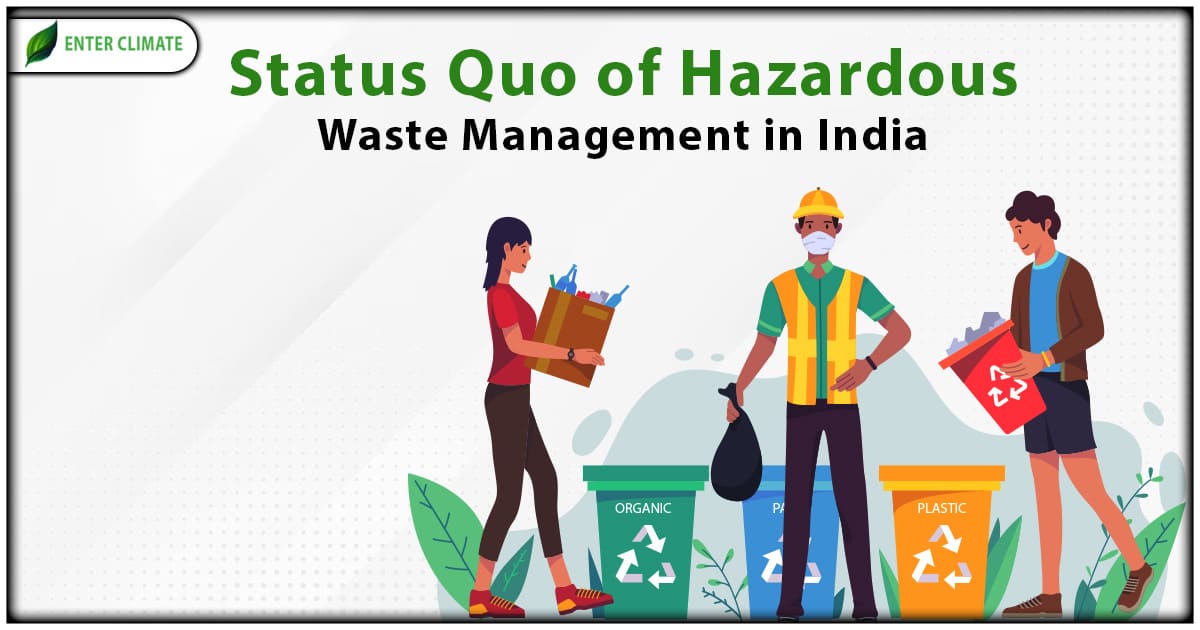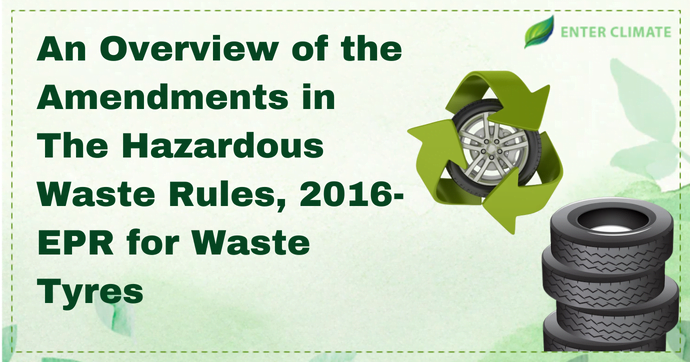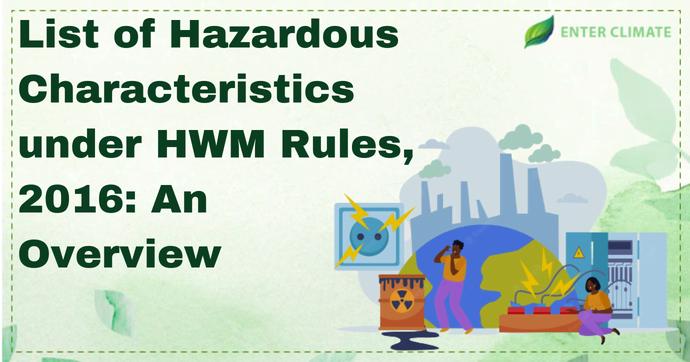The Status Quo of Hazardous Waste Management in India: A Critical Study
 10 Aug, 2023
10 Aug, 2023 
Throughout history, humankind has consistently produced waste materials resulting from various activities. The root of this issue lies in our industries’ increasing demands and needs, leading to both a quantitative and qualitative increase in waste production. To address this concern, the Ministry of Environment & Forests, Government of India, acted by introducing the Hazardous Waste (Management & Handling) Rules on July 28, 1989, under the provisions of the Environment (Protection) Act, 1986[1] for the effective management of Hazardous Waste Management in India. This legislation underwent subsequent amendments in 2000 and 2003. Additionally, to ensure the effective management of hazardous waste, particularly solids, semi-solids, and other industrial wastes not covered by the Water (Prevention and Control of Pollution) Act, 1974, and the Air (Prevention and Control of Pollution) Act, 1981, the Hazardous Wastes (Management, Handling, and Transboundary Movement) Rules, 2008 were implemented. The primary goal is to enable authorities to control the storage, transportation, treatment, and disposal of waste in an environmentally responsible manner.
Categorisation of Hazardous Waste in India
Hazardous Waste can be broadly classified into two main categories:
- Various industries generate hazardous waste in India. The major industries responsible for generating hazardous waste in the country include petrochemicals, pharmaceuticals, pesticides, paint and dye, petroleum, fertilisers, asbestos, caustic soda, inorganic chemicals, and general engineering industries. The hazardous waste produced by these sectors contains toxic, flammable, reactive, corrosive, or explosively hazardous substances such as heavy metals, cyanides, pesticides, complex aromatic compounds, and other chemicals.
- Hazardous Waste Management in India is imported from foreign countries for recycling and re-processing purposes. This type of waste is also referred to as “imported waste” and serves as a raw material for certain industries in India or is utilised primarily for metal recovery.
Role of HWM Rules, 2015 in Hazardous Waste Management in India
The Hazardous and Other Wastes (Management & Transboundary Movement) Rules, 2016 represent a significant step in differentiating between Hazardous Waste and other types of waste, such as Waste tyres, paper waste, metal scrap, used electronic items, etc. These “Other Wastes” are seen as valuable resources for recycling and reuse, complementing industrial processes and alleviating the pressure on the country’s virgin resources.
Key features of the Rules involving Hazardous Waste Management in India are:
- The scope of the Rules has been expanded to include “Other Waste.”
- A waste management hierarchy has been incorporated, emphasising prevention, minimisation, reuse, recycling, recovery, co-processing, and safe disposal in order of priority.
- Various forms for permissions, import/export, annual returns, transportation, etc., have been significantly revised, reflecting a stringent yet simplified approach to waste management.
- Infrastructure requirements for waste processing have been prescribed as Standard Operating Procedures (SOPs), specific to waste type, to be followed by stakeholders and monitored by SPCB/PCC during authorisation.
- A simplified procedure now enables a single-window clearance to set up hazardous waste disposal facilities and import other wastes.
- Co-processing is encouraged as a preferred mechanism over disposal, promoting the use of waste as a supplementary resource or for energy recovery.
- The approval process for co-processing hazardous waste for energy recovery is now based on emission norms rather than trial periods.
- Import/export procedures have been streamlined by simplifying documentation and revising the list of regulated waste for import/export.
- Certain items have been prohibited from import, including waste edible fats and oil, household waste, critical care medical equipment, tyres for direct reuse, solid plastic wastes including PET bottles, waste electrical and electronic assemblies’ scrap, and certain chemical wastes in solvent form.
- State Governments are responsible for environmentally sound management of hazardous and other wastes, including setting up industrial space, registering workers involved in waste activities, forming worker groups for facility setup, conducting industrial skill development, and ensuring worker safety and health.
- The list of processes generating hazardous waste has been updated to account for industry technological advancements.
- The list of Waste Constituents with Concentration Limits has been revised to align with international and drinking water standards.
- State Governments are authorised to prepare an integrated plan to effectively implement these provisions and submit an annual report to the Ministry of Environment, Forest, and Climate Change.
- State Pollution Control Boards (SPCBs) are mandated to prepare an annual inventory of waste generated, recycled, recovered, utilised (including co-processed), re-exported, and disposed of, submitting it to the Central Pollution Control Board.
Legislator and Regulatory Framework of Hazardous Waste Management in India
The importance of protecting the environment while ensuring the sustainable use of resources is evident in India’s constitutional framework and international commitments. Part IVA (Art 51A – Fundamental Duties) of the Constitution imposes a duty for every citizen to safeguard and enhance natural environment, forests, lakes, rivers, and wildlife, while also showing compassion towards living creatures. Part IV (Art 48A – Directive Principles of State Policy) also emphasises that the State should strive to protect the environment and safeguard the country’s forests and wildlife.
The regulatory and administrative core of the environmental sector consists of the Ministry of Environment, Forests, and Climate Change (MoEF & CC) and the pollution control boards/committees, including the CPCB and SPCBs.
To manage Hazardous Waste Management in India and regulate its export/import, the Hazardous Wastes (Management and Handling) Rules, 1989, were notified under the Environment (Protection) Act, 1986. These rules underwent amendments in 2009 and 2010. In 2016, the new Hazardous and Other Wastes (Management & Transboundary Movement) Rules were introduced. Hazardous waste is any waste with physical, chemical, reactive, toxic, flammable, explosive, or corrosive characteristics that pose a danger to humans or the environment alone or in contact with other wastes or substances.
Key features of these Rules include the expansion of their scope to include “Other Waste,” the incorporation of a waste management hierarchy emphasising prevention, minimisation, reuse, recycling, recovery, co-processing, and safe disposal in order of priority. The management approach has become more stringent, and approval procedures have been simplified. The roles of the authorities involved are clearly defined.
Solutions to Manage Hazardous Waste in India
The revamped HWM Rules of 2016 have established guidelines to ensure hazardous waste prevention, minimisation, recycling, and safe disposal. However, there is a need for significant amendments to improve the effectiveness of these rules. The Ministry of Environment may consider amending the Rules to include standard operating practices and standardised protocols for treating and disposing of hazardous waste by generators, as well as inspection and enforcement mechanisms by State Pollution Control Boards. This will create uniformity and enhance the overall effectiveness of waste management practices across India.
- One crucial aspect that the new Rules overlook is the treatment and disposal of existing hazardous waste, which amounts to large quantities lying abandoned in various Industrial Estates and open spaces. Prioritising the treatment and safe disposal of this waste should be a primary concern.
- To ensure compliance with the rules, it is essential to mandate applicants in the industry to submit a Bank Guarantee while seeking authorisation from the SPCB. This financial threat will incentivise non-compliant industries to take corrective actions within negotiated timeframes.
- Third-party monitoring by independent experts outside the regulatory mechanism, as practised in developed countries like the USA, has shown positive results. Introducing a specific Third Monitoring Mechanism or surprise checks in hazardous waste management can enhance its scientific and technical aspects.
- Technological advancements in the processing, treatment, and disposal of solid waste, such as energy-from-waste, should be recognised as an independent industry. This will attract investment in the sector through public-private partnerships or other economic models, making waste management more viable in India.
- To deter non-compliance, stringent penal provisions should be implemented, enabling SPCBs and CPCBs to impose fines and penalties under the “polluters pay” and “precautionary principle.”
- Strengthening the regulatory mechanism by addressing challenges like financial resources, staffing, standardised protocols, and legal enforcement authority is essential. The government should ensure uniformity in enforcement across all SPCBs and expedite the resolution of environmental cases through the National Green Tribunal and State Pollution Control Boards.
- The government can learn from success stories in managing hazardous waste in the European Union and devise suitable policies for India.
- For infrastructure development, each State Government should allocate a sufficient area in Industrial Estates/Zones/Corridors/SEZs exclusively for setting up common facilities for hazardous waste disposal. This shared facility can be managed by a society comprising waste generators, local bodies, and NGOs, reducing the burden on individual units and promoting cost-effective waste disposal.
- Import of Hazardous Waste Management in India should be subjected to a specific ban or moratorium for a certain period to prevent India from becoming a dumping destination under the guise of recycling.
- A Compulsory Hazardous Waste Management Plan with a top-down approach should be laid down by the Government of India to hold all authorities and waste generators accountable.
- To address hazardous waste management at the district level, common hazardous waste treatment facilities should be set up in each district to ensure systematic operation and monitoring, discouraging individual facilities or self-disposal methods.
Conclusion
Managing Hazardous Waste Management in India remains a critical area of concern, requiring vigilant attention and effective measures. Generating hazardous waste from various sources, including industries, poses significant threats to health of humans and the environment. While efforts have been made to regulate and manage hazardous waste through the Hazardous and Other Wastes (Management & Transboundary Movement) Rules, 2016, and subsequent amendments, there is still a need for further improvements and stringent enforcement. Addressing the challenges posed by hazardous waste necessitates a comprehensive approach involving stakeholders from the government, industries, communities, and civil society. Promoting the three Rs – Reduce, Reuse, and Recycle – can significantly mitigate hazardous waste generation, minimising its impact on the environment. It is recommended to take expert advice to ensure the documents that will be required for Hazardous waste management in India based on the business operation area.
FAQs
The four distinct categories are identified as listed wastes, characteristic wastes, mixed wastes and universal wastes.
Hazardous waste disposal can occur at individual waste generators’ captive treatment facilities or at centralised TSDFs.
Black bins indicate hazardous waste, including chemicals, harmful medications, and chemotherapy materials. Blue bins, on the other hand, are designated for non-hazardous solid waste.
In simple terms, hazardous waste is a type of waste that possesses characteristics making it dangerous or potentially harmful to health of human or the environment.
MoEF issued the Hazardous Wastes (Management and Handling) Rules, 1989, by the provisions of the Environment (Protection) Act, 1986.
As per a report from The Energy and Resources Institute (TERI), India produces more than 62 million tons (MT) of waste annually. Out of this total waste generated, only 43 MT is collected, with 12 MT undergoing treatment before disposal, while the remaining 31 MT is directly discarded in waste yards.
Hazardous wastes can manifest as solids, liquids, sludges, or contained gases, predominantly from chemical production, manufacturing, and other industrial processes.
Chemical, thermal, biological, and physical techniques can all be utilised to treat hazardous waste.
Reduce, reuse, and recycle: The three fundamental actions to support the environment.
In the context of this assessment, these sources are identified as contributing to four primary waste categories: municipal solid waste, industrial waste, agricultural waste, and hazardous waste.
Read our Article: Overview Of Hazardous Waste Management Rules In India
Categories
Latest Post
Air pollution Dispersion Modeling
Natural Disaster Risk Assessment
Endangered Species Protection
Aquifer Recharge Project
Sustainable Sanitation Solutions














